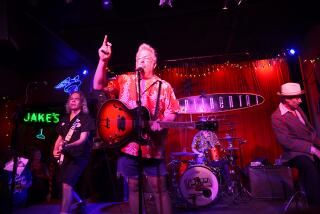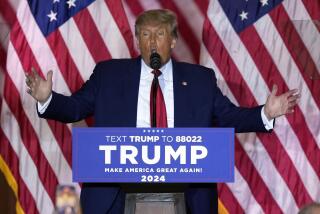As Nixon Turns 75, a Town Remembers
- Share via
Seventy-five years ago today, Yorba Linda lemon grower and handyman Frank Nixon ran to the home of neighbor Ella Furnas and asked her to stay with his laboring wife, Hannah, until the doctor came.
The expectant father was “awfully nervous,” even though this was the couple’s second child, Mrs. Furnas recalled years later for historians from the Oral History Program at Cal State Fullerton. Mrs. Furnas had two daughters of her own, but she was nervous too, she admitted in the 1971 interview.
“I was very much frightened and feared he (the doctor) wouldn’t make it in time, but he did manage to get there,” Mrs. Furnas said.
Soon afterward, the doctor handed newborn Richard Milhous Nixon to Mrs. Furnas while he dealt with the infant’s mother.
“I had never been in such a predicament,” Mrs. Furnas said about caring for the newborn, “so I just didn’t know what to do. . . . I was awfully glad when it was all over, and I was allowed to go home.”
The future President’s impromptu midwife visited frequently over the days that followed, checking up on the new baby. Soon afterward, however, Mrs. Furnas moved away and lost touch with the Nixons.
The town of Yorba Linda, on the other hand, has kept up an on-again, off-again relationship with its native son over the years, a relationship that is definitely back on these days as the city prepares what was once Frank Nixon’s lemon grove as the site of the Richard M. Nixon Presidential Library.
The city hasn’t always asserted its claim to Nixon’s fame--or the shame that came with his resignation. The man’s popularity on the national level has been bouncing up and down for four decades, and Yorba Linda has tended to go along with the prevailing view in the nation.
Sure, there are a few stubborn Yorba Linda folks who never stopped giving directions to their homes beginning with, “You take the Richard Nixon Freeway. . . .” (The California Assembly bestowed the name on a small stretch of Imperial Highway in Yorba Linda after Nixon was elected President, only to strip the road of its title after the Watergate scandal.)
But if they advertise their hometown at all, residents are more likely to use the city’s unofficial, apolitical license plate frame slogan, “Yorba Linda: Land of Gracious Living.”
Nixon’s stock was up in the ‘50s, when he was vice president, and in 1969, when he was sworn in to the nation’s highest office. Then, Yorba Lindans put up plaques and monuments commemorating the historic event to which Mrs. Furnas was a somewhat reluctant witness.
When his fortunes plunged, after his “you won’t have Dick Nixon to kick around anymore” speech in 1962--and even more so in 1974, when he became the only American president to be driven from office--the proud citizens of Yorba Linda weren’t always quick to jump in and challenge when someone said, “Nixon? Isn’t he from Whittier?”
For example, a brochure of the city’s historical sites compiled several years ago mentions the town’s first apartment building and its first garage, among other sites. But mention of the Nixon birthplace is conspicuously absent.
(There is, however, no hard evidence that Woody Allen had that brochure in mind when he wrote “Sleeper.” Allen used a black-and-white clip of a Nixon speech in the movie. “Some of us have a theory that he might once have been a president of the United States, but that he did something horrendous, so that all records, everything was wiped out about him,” says a scientist of the future to a fresh-from-the-freezer Woody as they watched the clip together. “Yes, that’s right,” Allen replies.)
A county history book published after Nixon’s vice presidential years, but before his presidency, describes him only as the cousin of writer Jessamyn West, also a Yorba Linda native.
During Nixon’s first term in the White House, local citizens proudly erected a monument--made with stone samples from each of the 50 states--on Yorba Linda Boulevard in front of the little frame house where he was born. They got the telephone company to donate a stand for the guest register (it looks remarkably like one of those walk-up pay phone booths, without the phone).
Every morning a volunteer would stop by the house to put fresh paper in the register; every evening he or she would collect the day’s signatures and take them indoors for safekeeping.
But after Nixon resigned and retreated to his oceanfront estate in San Clemente, the paper in the birthplace guest register ran out and no one bothered to replace it. The red, white and blue paint on the stand faded and wasn’t touched up.
Of course, there’s a lot of sprucing up going on around the place now, according to Yorba Linda Mayor Roland Bigonger, who was also a founding member of the local Nixon Birthplace Foundation and one of the volunteers who once kept the guest register current.
“There are some things we really should have taken care of a long time ago,” Bigonger says. “We need to replace that guest register; it looks really bad.”
Bigonger is looking forward to opening to the public Nixon’s birthplace. It’s now home to a local school custodian and his family, and visitors are asked not to invade their privacy. (The house occupied by the elderly woman, who received so much recent publicity when she said she didn’t want to leave for the Nixon project, is on adjoining property that once belonged to the elder Nixons; Nixon himself never lived there.)
“We have acquired 90% of the furnishings that were there when he was born, even the wheelbarrow that was in the yard. We had great expectations, but the era of the resignations certainly slowed us down.”
Coincidentally or not, Nixon’s image nationwide is undergoing some refurbishing as well.
Last fall, at a conference on the 37th president at New York’s Hofstra University, historians gathered to talk about what some of them dubbed “The Age of Nixon,” looking beyond the Watergate scandal and heralding him as an important historical figure, second in this century only to Franklin D. Roosevelt, according to some scholars.
“He’s rising again,” said Dr. Harry Jeffrey, professor of history at Cal State Fullerton and director of the university’s Richard M. Nixon Oral History Project.
“Richard Nixon is our most durable politician,” said Jeffrey, who attended and spoke at the Hofstra conference. “His book was called ‘Six Crises,’ and maybe Watergate was the seventh crisis. He’s been counted down and out many times, but he seems to have seven lives, at least.”
(A similar opinion was expressed in a more informal fashion last week by a visitor to Disneyland who sported a large “Nixon’s the One” button on his shirt. “He’s a damn sight better than what we’ve got in the White House now,” the man replied to a question about the button, and several other people in the line for “Star Tours” eagerly voiced their agreement. If there were dissenters, they kept quiet.)
Jeffrey, who moved to Orange County in 1969 to start the Cal State Nixon project, says he noticed that Yorba Linda’s attitude toward its most famous product changed over the years. “A lot of Yorba Linda people were proud of him, very, very proud of him, between 1969 and 1972,” Jeffrey said. “But in ’73 and ‘74, when the Watergate mess was so prominent, a lot of Yorba Lindans tended to want to have Yorba Linda disassociate itself from Nixon. That carried over for a few years.
“But time is a great healer, and the Nixon presidency and career are much more than Watergate. People in Yorba Linda and Whittier (where the Nixons moved when Richard was 9) are starting to realize the importance of the man in history,” Jeffrey says.
Bigonger, however, insists that in the 33 years he has lived in Yorba Linda, “I have not seen any great differential in (Nixon’s) popularity. When I came here, people were very proud of their native son. Even when the fateful day of resignation occurred, there was probably more of a feeling of sorrow for the gentleman.
“Overall, my perception of Richard Nixon here in this community has always been one of ‘maybe mistakes were made, but he was a good president.”’
More to Read
Sign up for Essential California
The most important California stories and recommendations in your inbox every morning.
You may occasionally receive promotional content from the Los Angeles Times.













